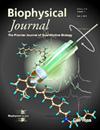大生物分子系统的路径采样挑战:abl -伊马替尼动力学的RETIS和REPPTIS
IF 3.2
3区 生物学
Q2 BIOPHYSICS
引用次数: 0
摘要
预测药物-蛋白质相互作用的动力学对于理解药物疗效至关重要,特别是在个性化医疗中,蛋白质突变可以显著改变药物停留时间。本研究采用复制交换转移界面采样及其部分路径变异来研究伊马替尼与Abelson非受体酪氨酸激酶(ABL)的解离动力学和与慢性髓系白血病治疗相关的突变体。这些路径采样方法提供了一种无偏差的替代方法,传统的方法需要定性预定义的反应坐标。然而,abl -伊马替尼解离的复杂自由能格局提出了重大挑战。多亚稳态和正交势垒导致平行解结合途径,使基于迁移界面采样的方法的收敛变得复杂。尽管采用了异步副本交换等计算效率策略,但完全收敛仍然是难以捉摸的。这项工作提供了高维生物系统中路径采样的关键评估,讨论了增强初始化策略的必要性,先进的蒙特卡罗路径生成移动,以及机器学习衍生的反应坐标,以最小的先验知识改善药物解离的动力学预测。本文章由计算机程序翻译,如有差异,请以英文原文为准。
Path sampling challenges in large biomolecular systems: RETIS and REPPTIS for ABL-imatinib kinetics
Predicting the kinetics of drug-protein interactions is crucial for understanding drug efficacy, particularly in personalized medicine, where protein mutations can significantly alter drug residence times. This study applies replica exchange transition interface sampling and its partial path variant to investigate the dissociation kinetics of imatinib from Abelson nonreceptor tyrosine kinase (ABL) and mutants relevant to chronic myeloid leukemia therapy. These path sampling methods offer a bias-free alternative to conventional approaches requiring qualitative predefined reaction coordinates. Nevertheless, the complex free energy landscape of ABL-imatinib dissociation presents significant challenges. Multiple metastable states and orthogonal barriers lead to parallel unbinding pathways, complicating convergence in transition interface sampling-based methods. Despite employing computational efficiency strategies such as asynchronous replica exchange, full convergence remained elusive. This work provides a critical assessment of path sampling in high-dimensional biological systems, discussing the need for enhanced initialization strategies, advanced Monte Carlo path generation moves, and machine learning-derived reaction coordinates to improve kinetic predictions of drug dissociation with minimal prior knowledge.
求助全文
通过发布文献求助,成功后即可免费获取论文全文。
去求助
来源期刊

Biophysical journal
生物-生物物理
CiteScore
6.10
自引率
5.90%
发文量
3090
审稿时长
2 months
期刊介绍:
BJ publishes original articles, letters, and perspectives on important problems in modern biophysics. The papers should be written so as to be of interest to a broad community of biophysicists. BJ welcomes experimental studies that employ quantitative physical approaches for the study of biological systems, including or spanning scales from molecule to whole organism. Experimental studies of a purely descriptive or phenomenological nature, with no theoretical or mechanistic underpinning, are not appropriate for publication in BJ. Theoretical studies should offer new insights into the understanding ofexperimental results or suggest new experimentally testable hypotheses. Articles reporting significant methodological or technological advances, which have potential to open new areas of biophysical investigation, are also suitable for publication in BJ. Papers describing improvements in accuracy or speed of existing methods or extra detail within methods described previously are not suitable for BJ.
 求助内容:
求助内容: 应助结果提醒方式:
应助结果提醒方式:


